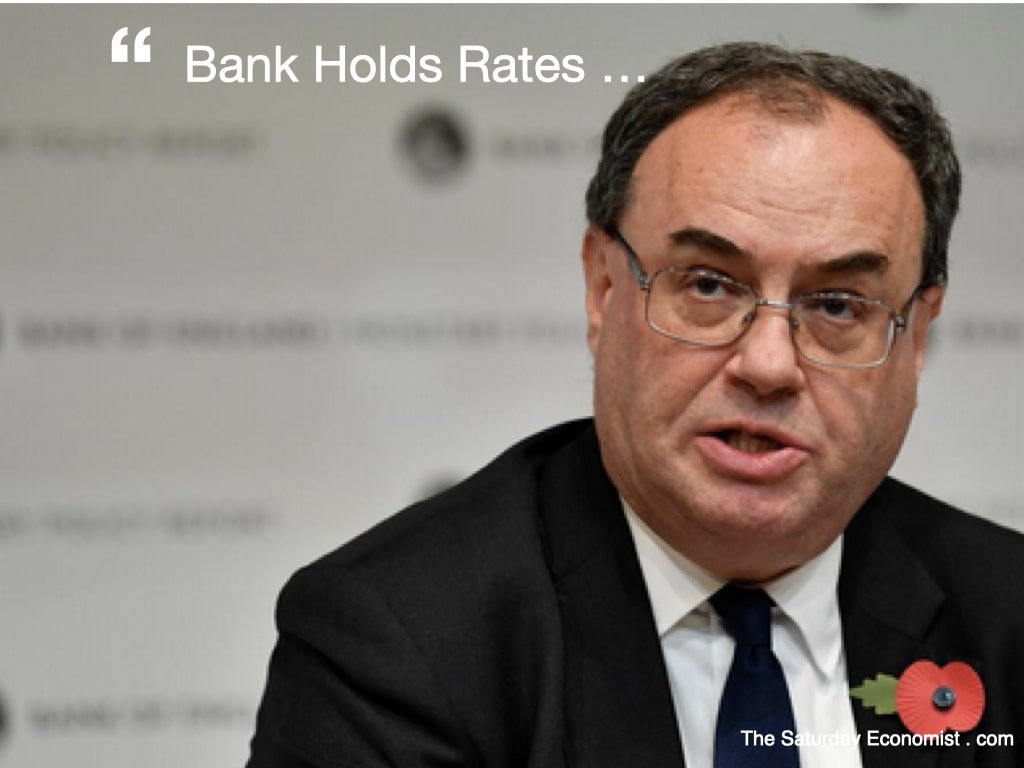|
The Vote is Seven to Two ...
The MPC voted to keep rates on hold this month. Markets misread the signals from the Bank. In the November meeting, just two members voted for a fifteen basis points rise in rates. It wasn't even a close call. Sterling fell, closing at $1.3489 against the dollar and down against the Euro at €1.1669. Ten year bond yields slumped to close at 0.85 down 18 points in the week. Volatility is returning to Forex, it has become a constant in the bond markets. The Governor took some flack, Andrew "Bailout" the call. As the successor to "Mark Carnage", he has yet some way to go before becoming the totally "unreliable boyfriend". Dave Ramsden and Michael Saunders were the hawks on the panel, the Governor and Silvana Tenreyro the notable doves. All members were convinced of the need to maintain the stock of corporate bonds at £20 billion. Probably because it was "chump change", in the grand scheme of things. Most had forgotten why they had bought them in the first place. Three members voted to reduce the target stock of UK government bond purchases from £875 billion to £855 billion. Catherine Mann, jumped onto the hawks perch, clearly forgetting the Treasury will have to issue over £180 billion bonds this year. The DMO will need more help from the buyer of last resort. No time to cut the cord just yet. The Governor may have said "The Bank will have to act" but gave no indication of the timeline. "It was a conditional statement" he explained "We make a lot of conditional statements." A move before the end of the year was always a long shot. Supply side bottlenecks do not form part of a monetary policy reaction function. "Raising rates will not cut gas prices, nor will it increase deliveries of semi conductor chips". The MPC will need time to assess the movements in the labour market as the furlough effect unwinds. "The labour market does look tight" the Governor said. If evidence develops of "inflationary expectations" becoming anchored, then rates are likely to rise. But when? The Bank has lowered the forecast for growth to 7% this year and 6% next. It has raised the forecast for inflation to 4.5% in the final quarter peaking at around 5% in April 2022, averaging over 3% over the year. Markets are now plotting an increase in rates to 0.25 early next year, rising to perhaps 1% by the end of the year. Will this be enough to return inflation to target? Will the Bank move ahead of the Fed and risk damaging the recovery in the year ahead? Our modified Taylor rule suggests rates could rise to 1.5% by the end of the year. 1% by year end now becomes our central scenario. The first hike may be just in time for Easter, that's on the 17th April next year. Chocks away, foreign travel is increasing. Catch 2022, may be the year we leave Planet ZIRP! Tickets refundable of course ... Fed Begins To Taper ... The Fed voted to maintain the target range for the federal funds rate at 0.00% to 0.25% this month. No surprise for markets over in the U.S. "Jerome the Powerful" holds court. As indicated, the committee decided to reduce the monthly pace of net asset purchases by $10 billion for Treasury securities and $5 billion for mortgage backed securities. The first cuts would take place in November and December. By the end of the year, the December spend would be $60 billion and $30 billion per month. The Committee judges that similar reductions in the pace of purchases will likely be appropriate each month. The distended Fed balance sheet would be on a firm diet by the end of June. US yields fell by thirteen basis points in the week. The Dollar rallied. The move had been well flagged and well received. A lesson in central bank communication perhaps. In the UK it is not clear why MPC members make so many market sensitive speeches, often with conflicting messages about policy direction. By the end of the week, news of over 500,000 new jobs added to Uncle Sam's workforce in October. Inflation CPI hit 5.4% in September. Congress approved A $1.2 trillion deal for infrastructure spending. The Fed is unlikely to move on rates despite the fall in the unemployment rate to 4.6%. Markets reacted with a bounce. The Dow, S&P and Nasdaq moved to record highs. The Dow closed above 36,000. *The prophetic writings of columnist James K. Glassman and economist Kevin A. Hassett were finally proved correct, just twenty years later. *Dow 36,000: The New Strategy for Profiting From the Coming Rise in the Stock Market is a 1999 book by syndicated columnist James K. Glassman and economist Kevin A. Hassett. they argued that stocks in 1999 were significantly undervalued and concluded that there would be a fourfold market increase with the Dow Jones Industrial Average rising to 36,000 by 2002 or 2004.
0 Comments
Leave a Reply. |
The Saturday EconomistAuthorJohn Ashcroft publishes the Saturday Economist. Join the mailing list for updates on the UK and World Economy. Archives
July 2024
Categories
All
|
| The Saturday Economist |
The material is based upon information which we consider to be reliable but we do not represent that it is accurate or complete and it should not be relied upon as such. We accept no liability for errors, or omissions of opinion or fact. In particular, no reliance should be placed on the comments on trends in financial markets. The presentation should not be construed as the giving of investment advice.
|
The Saturday Economist, weekly updates on the UK economy.
Sign Up Now! Stay Up To Date! | Privacy Policy | Terms and Conditions | |

 RSS Feed
RSS Feed